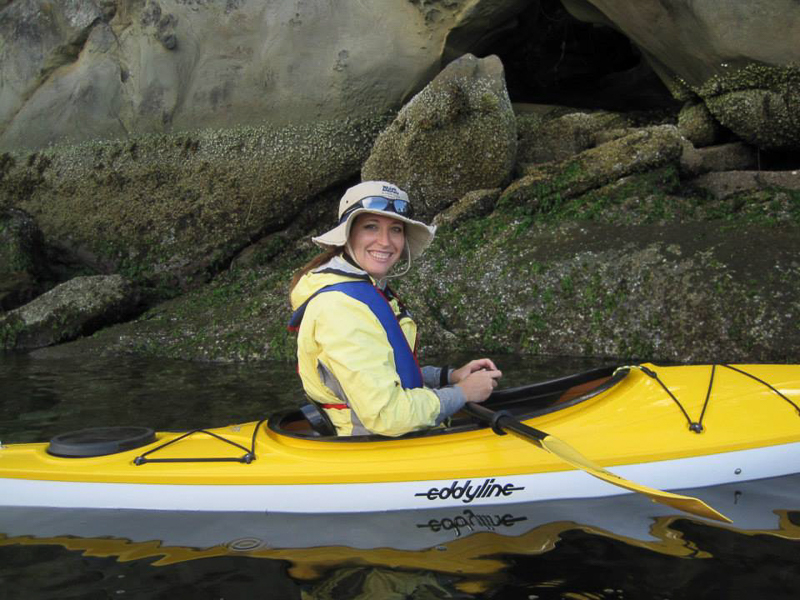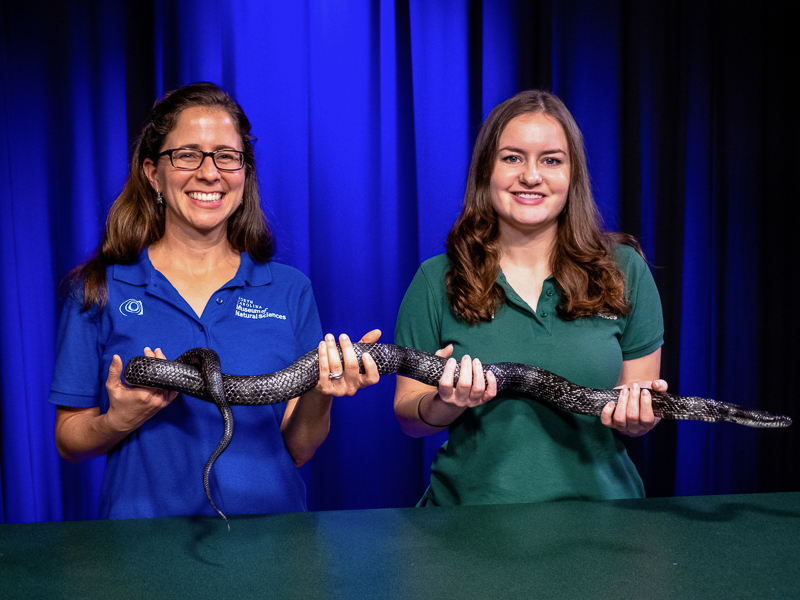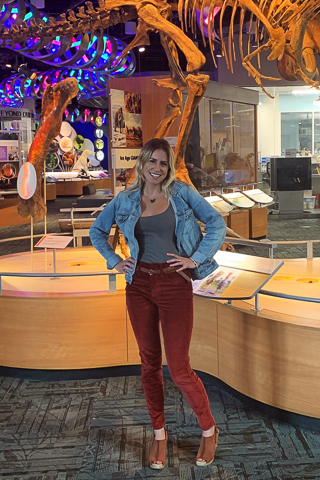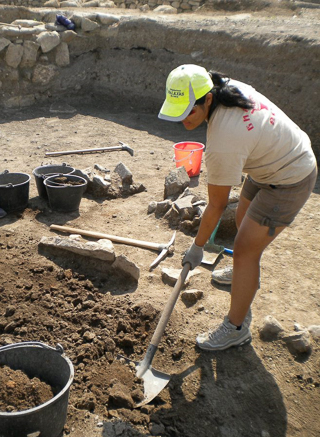Women Who Inspire: Celebrating STEM
For immediate release ‐ March 25, 2021
Contact: Micah Beasley, 919.707.9970. Images available upon request
Join the Museum for a special celebration of Women’s History Month and women in STEM. Throughout March, the Museum will spotlight some of the amazing women who help make our institution great, sharing their journeys and the women who helped pave the way.
Jessica Andreasen: Jane Goodall | Martha Fisk: Eugenie Clark | Jess Wackes: Hedy Lamarr | Nicole Coscolluela: Dr. Kristina Killgrove
 Jessica Andreasen in a kayak.
Jessica Andreasen in a kayak.
Jessica Andreasen is the head of volunteer and intern programs coordinator and has worked at the Museum for nearly two years.
Who is a woman in the field of science who inspires you?
Jane Goodall.
What inspires you most about this person?
Dr. Goodall is not only a pioneer for women in science, but a powerful advocate for environmental sustainability. Her research on chimpanzees and other primates has brought greater understanding of human evolution and how we are all connected to the natural world and to one another.
I had the opportunity to volunteer as a docent for the Chimpanzee and Human Communication Institute in Washington. The family of chimpanzees I worked with spoke sign language and it was one of the most amazing, awe-inspiring moments. I knew afterward that I wanted to go into the STEM field with an emphasis on education.
Dr. Goodall’s impact influenced how I viewed the world and gave me a broader perspective on how we are all interconnected. She inspires passion in me to help connect children with the natural world in ways they can relate to, while encouraging them to take action to become good stewards of the environment.
How have you applied this inspiration over the course of your career?
As an environmental educator, it’s not only important to ask, “How do we impact this thing?” but to look at it from all angles and ask, “How does this impact me, too?” A good environmental education program starts with relevancy to connect the audience in a personal way to the subject. In this, Dr. Goodall excels and inspires, and I try to bring that same philosophy to Museum programs and opportunities.
What is your favorite quote attributed to Jane Goodall?
“Every individual matters. Every individual has a role to play. Every individual makes a difference.”
How did your own background shape your pursuit of science and nature?
Every woman on my dad’s side of the family was also an educator of some sort, starting back with my great-great-great grandmother, who was a botanist ahead of her time in the Pacific Northwest. I recently inherited her scientific collection of pressed plants complete with names and collection information on each one. The oldest is in the collection is nearly 110 years old and still slightly colorful!
For as long as I can remember, my parents would take us camping, swimming, hiking and skiing (both water and snow). I’m so thankful my parents let me get my hands dirty and do things that normally wouldn’t be considered “ladylike,” such as climbing trees, catching tadpoles in muddy puddles and picking up random bugs and spiders off the ground.
During a family vacation to the Caribbean when I was 12, I went snorkeling for the first time and my parents subsequently had a hard time keeping me out of the water! Ten years later, I went back to school for marine biology and got my SCUBA certification. This outdoor learning and nature immersive childhood is the reason my husband and I chose the home we currently live in, nestled in a forest with a creek in the backyard and something we hope to give our own child, who is due in June of this year!
How can women help other women in the STEM field?
Support, support, support! Support girls and young women to pursue careers in STEM fields. Support lifelong personal and professional development, as STEM fields are constantly evolving with greater knowledge and understanding. Support transgender women, women of color and women with disabilities who face additional challenges and/or barriers to their chosen fields. And, finally, support women supporting their families.
STEM fields can be demanding because of their very nature as fields that require lifelong learning. These fields are often chosen out of passion for the subject matter and pursued with a great deal of drive! But the challenges of balancing family and/or motherhood with a career often come with additional biases (unconscious or not) and barriers. These can cause women already in STEM fields, who have put a lot of time, effort and resources into pursuing their careers, to feel the need to sacrifice their careers for their families.
 Martha Fisk (left) and Museum Educator Laura Beth Speer.
Martha Fisk (left) and Museum Educator Laura Beth Speer.
Martha Fisk is the coordinator of virtual and offsite outreach for the NC Museum of Natural Sciences and has worked at the Museum for over 16 years.
Who is a woman in the field of science who inspires you?
Eugenie Clark.
What inspires you most about this person?
I remember reading Eugenie Clark’s memoir, “The Lady and the Sharks,” and being inspired by this woman who studied an animal that I feared: sharks. Reading her book changed the way I felt towards them as fear yielded to fascination.
Moreover, Clark turned her childhood love of marine animals into a lifelong career and she dedicated her life to understanding sharks and sharing her knowledge with others.
How have you applied this inspiration over the course of your career?
I have dedicated my career to sharing the wonders of nature and science with others. Helping children and adults make connections with the world around them through learning and wondering together is one of the best parts of my job.
How did your own background shape your pursuit of science and nature?
My parents encouraged my interests and signed me up for experiences that helped me learn more about the world around me. I still have an animal encyclopedia that I received in 1988 and a green box of Illustrated Wildlife Treasury cards. They signed me up for zoo camp and drove me back and forth when I became a zoo volunteer and camp counselor. We spent our family vacations visiting museums, historic sites and state and national parks around the country.
I realize now that my parents were sharing their own love of learning and exploring with me. They passed on the gift of curiosity that is at the heart of how I live in the world. Curiosity for science and nature is what I hope to pass along to all of the people I meet.
How can women help other women in the STEM field?
We can welcome new ideas and approaches. We can share our love of science. We can provide opportunities for other women to join our field of study.
Women Who Inspire: Jess Wackes — Hedy Lamarr

Jess Wackes
Jess Wackes is the social content manager for the NC Museum of Natural Sciences and has been in that role for over two years.
Who is a woman in the field of science who inspires you?
It is difficult to choose just one, but this Women’s History Month, I will happily highlight Hedy Lamarr.
What inspires you most about this person?
As a Jewish woman born in Austria in 1914, Hedy Lamarr didn’t have an easy path in front of her. Nevertheless, by the 1940s she built a career for herself as a successful actress during the Golden Age of Hollywood, while also co-inventing an early version of frequency-hopping, spread-spectrum communication for torpedo guidance — the building blocks of what enables Wi-Fi and Bluetooth today.
Lamarr seemed to have an internal fire that fueled resilience and duty in preserving her authentic self, especially in the face of a systemically sexist and objectifying industry, at a time of global war and when anti-Semitism was rampant. Hedy Lamarr was brilliant – she knew who she was and she knew her value.
How have you applied this inspiration over the course of your career?
Lamarr’s story inspired an important understanding of work-life balance for me. Through her, I have come to understand that a successful professional must also have a textured personal life filled with her interests, adventures and personal growth.
As a professional communicator, I must have a personal foundation that keeps me constantly ideating, always learning and forever inspired. That’s how I’ve found true joy in my profession and why I believe your personal relationship with your own life will further fuel and enhance your professional performance.
What is your favorite quote attributed to Hedy Lamarr?
“Give the world the best you’ve got. You will get kicked in the teeth. Give the world the best you’ve got anyway.”
How did your own background shape your pursuit of science and nature?
Growing up, my family moved around the country about 20 times, which certainly gave me an appreciation of nature. I was lucky for the opportunity to live by the ocean, in the mountains, in deserts and everywhere in between. Because of that experience, I spend a lot of time connecting with different forms of life and about the many different people and cultures across our country. I might not know everything there is to know about the natural world, but I am certainly devoting my life to trying, and I am always happy to share that wonder and joy with NCMNS audiences.
How can women help other women in the STEM field?
Women supporting women comes down to direct advocacy, extending grace and empathy to each other and being a supportive, active listener.

Nicole Coscolluela
Women Who Inspire: Nicole Coscolluela — Dr. Kristina Killgrove
Nicole Coscolluela is the Head of the North Carolina Science Museums Grant Program and has been in that role for nearly two years.
Who is a woman in the field of science who inspires you?
Dr. Kristina Killgrove, a professor in anthropology at UNC Chapel Hill, is an inspiration to me. She researches Roman bioarcheology, which is also my area of academic study.
What inspires you most about this person?
What distinguishes her as a leader in her field is her commitment to public outreach and science communication. She goes beyond simply writing for an academic audience and makes her research topics digestible for the general public by her active, approachable social media presence and contributions to Forbes and other publications.
How have you applied this inspiration over the course of your career?
Community outreach and connection is what inspired my passion for working at museums in the first place. Museums serve an essential public good, but it is critical that institutions like ours communicate with diverse audiences and inspire connection to science in a meaningful way.
How did your own background shape your pursuit of science and nature?
Fortunately for me, my parents never pressured me to become a doctor, nurse or lawyer (like many Filipino parents are known to do!). Instead, they fostered my curiosity of the natural world. They let me catch animals, they took me to visit zoos, they let me pet farm animals and play in the dirt; all this served my development and pursuits. I am grateful my family exposed me to a lot of experiences and supported the career path I chose for myself.
How can women help other women in the STEM field?
Encouragement works wonders.

